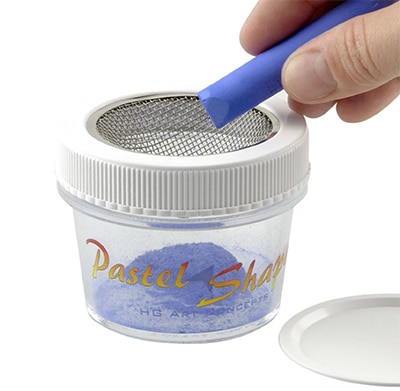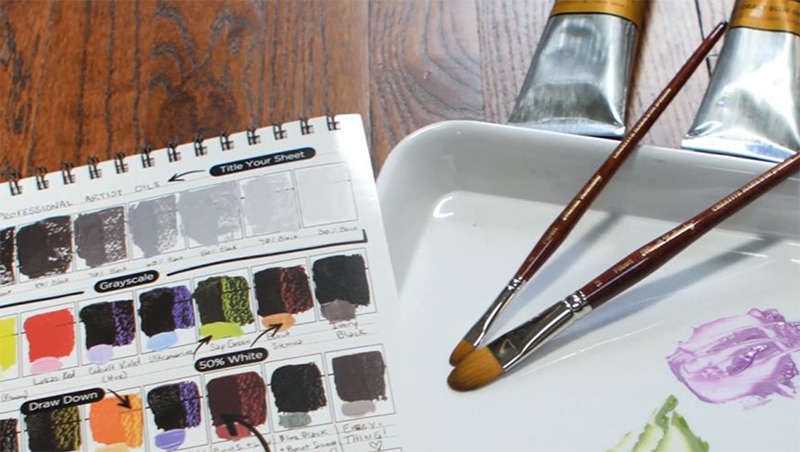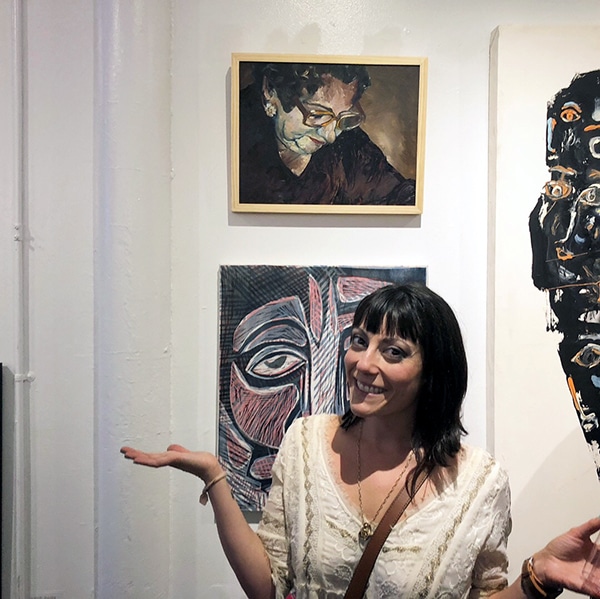Heather Goldstein invented her first product at age 16 after lots of conversations with the artists who shopped at her family’s fine art supply store, Jerry’s Artarama. Fast forward to today, and Goldstein is part of the third generation in business, where she’s made her talent for dreaming up new art supplies into her job in product development across three retail stores and online. “The cool thing is a lot of the stuff that I’ve come up with is just so simple,” she says. “Like, how does this not exist yet?” In this interview, Goldstein, who is also a painter, discusses product development strategy, her artistic practice, and how a good art supply organizer can solve your problems.
You’re the third generation to work at fine art supplier Jerry’s Artarama. Tell us how the business came to be.
My grandfather started the company in 1968. We were originally from New York, where he used to manage a toy store in Great Neck. He started to bring in art supplies like watercolor sets for the wealthy women who would shop there and bring their children in. After that shopping center ended up burning down, he thought an art-supply store would do really well there, so he and my grandmother Arlene decided to open one. Because this was back in the day and everybody knew Jerry, they decided they had to call it Jerry’s something. My grandmother used to collect matchbooks. And she had one that said Matcharama. There you have it!
It was funny for my dad, Ira, because when he was a little kid, his dad ran a toy store. In middle school and high school, my dad loved art, and his dad ran an art store. It was a small mom-and-pop shop, so there was a lot of free labor from him and my uncle David. They were working in the company ever since it was opened. Now my dad and my uncle own the company after my grandfather passed seven years ago. My brother Michael and I are still working in the business.
It’s funny because when we were growing up, we were total drama kids. I don’t think I realized how present art was in my life because if you asked me what I loved to do, I would say singing. But drawing and stuff like that was just something I did that was normal — I didn’t even think of that as a hobby. We always had art supplies around the house, we were always playing around with things. It’s normal for any kid when they’re young, but you find around elementary school, at some point, kids start to become a little more self-conscious, and that stops being so prevalent. Because of my family’s business, it never stopped being there.
When did you start working in the business?
We moved down to North Carolina when I was 9. When I was in high school, I worked in our retail store that had opened in Raleigh.
The business had gone from a one-store operation to two stores in the 70s. In the 80s, my uncle bought a mailing list of 2,000 people, and he and my dad created the first Jerry’s Artarama catalog, an 8-page pamphlet, and that’s what started our mail-order business. Our very retro company still calls it mail order. My uncle was the first in our industry to do mail-order art supplies back when art supply stores used to exist.
My dad and my uncle were really pioneers in different ways. My dad has always been really into computers and technology, and in the 90s, when the internet was getting bigger, he worked with a programmer and created our database. He was the reason we created a website. For our industry, we were the first ones promoting a web presence! We were trying to sell online and reach people in places that didn’t have an art supply store. It’s very cool, and I’m really lucky I’ve had my dad and my uncle as mentors and supporters because they think outside the box and try to do the next best thing — not just for the business but for artists.
The first product I ever created was when I was 16. At the time, I worked in the retail store in Raleigh, NC, and I really loved doing pastels – which I avoid at all times now because my dry hands can’t take all the chalkiness! Through talking to customers, I learned a lot about how to do pastels and different tips and techniques. That’s a really cool thing about working in the store: having those types of conversations with artists.
The stick comes in one size and one shape, and that’s it. It’s great for laying a lot of colors down, but if you want to get detail, it’s very difficult. So a lot of artists will shape their pastels with sandpaper or something like that to create a point or a sharp edge. Funny enough, even though I’ve gotten free art supplies my entire life, I’m so stingy with art supplies – I need to get every last bit out of my materials. I’m still like this with my paints! Every paint tube I have is squeezed out. When I was in college, I used to cut the tube open. It’s ridiculous. So, it was hurting my heart to shave down the pastels, especially the more expensive ones.

Heather Goldstein invented her first product, the pastel shaper, at age 16.
Whenever I would sharpen it, I would sharpen over a jar to save the pastel dust. I would also keep the color groups separate: the yellows in one jar, the blues in another jar, and so on. And it created these beautiful pastel shades. Then you can go back in with a paintbrush and paint in with your pastel drawing with those shavings you had saved.
I told my dad and uncle that it’d be really great if we had a cone-shaped mesh so that you could sharpen over mesh and it would fall into the jar – so we created a product that’s the
pastel shaper, and it does just that. It has a patent! It was a very cool process to do and speaks to the power of having a family that is so supportive of creativity and innovation.
You’ve had so many different roles at Jerry’s. Tell me a bit about your current role in product development strategy and what your day-to-day looks like.
I’ve officially been in product development since 2020, and it’s fantastic. When I went to college, I went to school for art and got a BFA in painting, a minor in art history, and a Bachelor of Arts in marketing. I wonder what you’re going to do with that degree? Art and business. I’m primarily an oil painter, but I use everything in my job. It’s a really great experience. I’ve had so many opportunities to do a number of different jobs, and I work with a lot of different artists and travel around the country. I really love my job! It’s really, really cool.
There are different aspects to my job. Jerry’s has a lot of proprietary products – items like paint brush brands or paint lines that we control the marketing of. One aspect of my job is going back and rebranding because a lot of this stuff, we get it in, and my dad and my uncle have been designing products since the 90s, so some of this stuff has been forgotten. I go back in and see how can we make this better, look better, and communicate better.
I also get to do real new product development. Under the brand HG Art Concepts, the first product was the pastel shaper. My second patent – the one I actually have hanging in my office – is for the Mezzo racks, an art supply organizer I’m really proud of.
Does your child make a mess when creating? As artists get older, that never changes. Somehow while you’re working, you get in the flow, and your whole area is just a mess. Mine is, at least! So I created these racks that you just take out what you’re using for that painting session – the paints, the brushes – and you put them in these nice racks, and it makes it very easy to see everything and keep them separate. And if you do have a studio space that you’re leaving set up, and you’re coming back tomorrow, this is perfect for that. It’s an art supply organizer and storage in one. It keeps your space looking clean and nice, especially for an artist expecting a studio visit. I also wanted to make sure they’re really affordable. They look nice in a wood laminate that matches most people’s studio furniture and easels, but you can put it together yourself. The best product development strategy fills a need that wasn’t being filled. There are a couple of new racks coming out soon that I’m very excited about!
You’re a painter, too! How does your art practice influence your work at Jerry’s and vice versa?
When I was in school, we used to have to do paint swatches and color mixing guides in our sketchbook. We’d have homework assignments to make 300 flesh tones. You’d prime your sketchbook paper, grid it out, do these color mixes, write the formulas – things like that are fantastic for making you a better painter because you really learn your colors that way, but it’s a huge pain in the ass.
I was in my studio a few years ago, and I wanted to paint but didn’t know what to paint, so I decided to do color mixing and clear my head. After an hour of prepping my sketchbook, I thought, I forgot how much this sucks! Wouldn’t it be cool if there was a product that already laid this out for me so I could just do straight to painting and not have to lay it out with a ruler? And then I thought, Oh yeah, I make products! The
painter’s color diary is my newest baby. It’s the next level of creating these swatches, a line so you can break it up to show tints, to show transparency. An artist can use it however they see fit.

The painter’s color diary by Heather Goldstein addresses a problem she encountered in her own studio practice.
I think that not enough artists play around with color mixing, so it’s hopefully something people will start doing more because they have the color diary to make it easier. You can use it to plan out your palette for your next painting. I’m really looking forward to seeing how other people use them! Everyone’s going to do their own thing.
Once I came out with ones for oil and acrylics, I thought, wait a minute, there’s more to explore. So the newest one has watercolor paper, and it’s 100% cotton watercolor paper. Anyone who uses watercolor has to swatch their paints and knows the color you see in the pan is not the one that comes out on the paper. The watercolor color diary is perfect for swatching your colors, you can use it for gouache and water-soluble oils, and have color guides you can turn to again and again.
The cool thing is a lot of the stuff that I’ve come up with is just so simple, like how does this not exist yet? Sometimes product development strategy is just spotting the super low-hanging fruit.

Heather Goldstein, pictured here with one of her paintings, finds inspiration for new products in conversation with fellow artists and while creating her own work.
How do you balance your artistic practice with your product development job?
I realized I’m never not going to paint. I think there are a lot of people like that. Regardless of what you’re doing, you’re an artist. You have this stuff in your head, you have these things you need to get out, and that’s just what you do. You always will make time for things that you love. It’s kind of like dating. I feel like a lot of people have dated those people who say they are just really busy right now, so that’s why I can only see you at 11 p.m. when I text you. You’re too busy for a relationship, but you’re not. You will always make time for what you want to make time for. Art is that way too.
I have a lot of friends who are full-time artists, and a lot of them are very regimented. They do commissioned work. It’s like a 9 to 5. They paint all day and get it done. That’s not the kind of artist I am. When it comes to painting, I can do whatever I want and do it at 2 a.m. if I feel the need. I’m able to paint, and I’m not super prolific, but I also don’t have to be. I have a painting of my brother I’m working on that I’m staring at that I’ve had in my studio for two years now. But that works out for me really well. Being an artist and painting is so imperative for what I’m doing with Jerry’s, but it’s not how I’m making my living, so I can just paint.
And since you’re involved in product development strategy: What’s one tool you cannot live without?
My palette knife. I really love palette knives. Obviously, color mixing is a very important thing to me, and I find a palette knife is the best way to mix colors. I also like painting with palette knives. I did a series of palette knife paintings because I was being very stingy with my paint in a lot of ways. Stingy, like I explained earlier, but also on the canvas. I needed to be doing more. It was kind of an exercise for me. When I started using a palette knife instead of a brush, it made me mix more paints on my palette, it added a lot of color and texture to the painting. And it was different, you know? It was a challenge. That’s a nice thing about not relying on having to sell my work to survive. I can do stuff like this. I can just be like, let me put all of the paint on the canvas and see what happens. Just to kind of mix things up! Sometimes things get stale, and you need to change it up.
